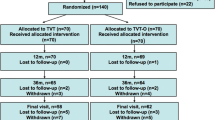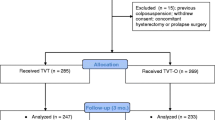Abstract
The aim of the present study was to evaluate the safety and efficacy of the tension-free obturator tape (TOT) procedure in patients having concomitant hysterectomy and/or pelvic reconstructive surgery. A chart review from August 2002 to December 2004 identified 341 consecutive female patients with stress urinary incontinence who had undergone a TOT procedure alone (Monarc only group) or a TOT procedure associated with hysterectomy or other pelvic reconstructive surgery (Monarc + other surgery group). Intraoperatively, three cases of hemorrhage occurred. No transfusions were required. There were no cases of bladder injury or injury to obturator nerves or vessels during needle passage via the transobturator route. Three cases of vaginal erosion were found at 3 months follow-up, but no tape removal was required. Two hundred fifty-four patients (74.5%) were contacted by telephone for a second follow-up (average 17 months, range 6–32) and the validated short forms of the Urogenital Distress Inventory (UDI-6) questionnaire and of the Incontinence Impact Questionnaire (IIQ-7) were administered. Results showed a very good quality of life score (0–7) in 93.3% patients. Globally, only three (1.2%) patients had persistent urine leakage related to physical activity. Severe voiding dysfunction occurred in five (2%) patients. The cure rate, considered as the complete absence of urine leakage (score 0 in questions 2 and 3 of the UDI-6), was 73.7% in the Monarc only group vs 57.4% in the Monarc + other surgery group. Pelvic floor defects, benign uterine disorders, and stress urinary incontinence can be safely treated with transobturator tape, using the Monarc device, and concomitant vaginal procedures.


Similar content being viewed by others
References
Ulmsten U, Falconer C, Johnson P, Jomaa M, Lanner L, Nilsson CG, Olsson I (1998) A multicenter study of tension-free vaginal tape (TVT) for surgical treatment of stress urinary incontinence. Int Urogynecol J Pelvic Floor Dysfunct 9(4):210–213
Delorme E (2001) Trans-obturator urethral suspension: mini-invasive procedure in the treatment of stress urinary incontinence in women. Prog Urol 11(6):1306–1313
DeTayrac R, Deffieux X, Droupy S et al (2004) A prospective randomized trial comparing tension-free vaginal tape and transobturator suburethral tape for surgical treatment of stress urinary incontinence. Am J Obstet Gynecol 190:602–608
Mellier G, Benayed B, Bretones S, Pasquier JC (2004) Suburethral tape via the obturator route: is the TOT a simplification of the TVT? Int Urogynecol J Pelvic Floor Dysfunct 15(4):227–232 (Jul–Aug)
Fischer A, Fink T, Zachmann S, Eickenbusch U (2005) Comparison of retropubic and outside-in transobturatori sling systems for the cure of female genuine stress urinary incontinence. Eur Urol 48(5):799–804 (Nov)
Bonnet P, Waltregny D, Reul O, De Leval J (2005) Transobturator vaginal tape inside out for the surgical treatment of female stress urinary incontinence: anatomical considerations. J Urol 173(4):1223–1228
Achtari C, McKenzie BJ, Hiscock R, Rosamilia A, Schierlietz L, Briggs CA, Dwyer PL (2005) Anatomical study of the obturator foramen and dorsal nerve of the clitoris and their relationship to minimally invasive slings. Int Urogynecol J Pelvic Floor Dysfunct 7:1–5
Tanussino KF, Kanzal E, Kolk D, Ralph G, Riss PA (2001) Tension-free vaginal tape operation: results of the Austrian Registry. Obstet Gynecol 98:732–736
Smith PP, Appell RA (2005) Pelvic organ prolapse and the lower urinary tract: the relationship of vaginal prolapse to stress uinary incontinence. Curr Urol Rep 6(5):340–343 (Sep)
Huang KH, Kung FT, Liang HM, Hang LY, Chang SY (2003) Concomitant surgery with tension-free vaginal tape. Acta Obstet Gynecol Scand 82:948–953
Uebersax J, Wyman J, Shumaker S et al (1995) for the Continence Program for Women Research Group: short forms to assess life quality and symptom distress for urinary incontinence. Neurourol Urodyn 14:131–139
Blanc E, Hermieu JF, Ravery V, Moulinier F, Delmas V, Boccon-Gibod L (1999) Interet de l’utilisation d’un questionnaire dans l’evaluation de la chirurgie de l’incontinence. Prog Urol 9:88–93
Kovac SR (1997) Vaginal hysterectomy. Bailliere’s Clin Obstet Gynaecol 11:95–109
Darai E, Jeffry L, Deval B, Birsan A, Kadoch O, Soriano D (2002) Results of tension-free vaginal tape in patients with ot without vaginal hysterectomy. Eur J Obstet Gynecol 103:163–167
Rafii A, Paoletti X, Haab F, Levardon M, Deval B (2004) Tension-free vaginal tape and associated procedures: a case control study. Eur Urol 45:356–361
Shindel AW, Klutke CG (2005) Urethral slings placed by the transobturator approach: evolution in the technique and review of the literature. Curr Urol Rep 6(5):385–392
Huang KH, Kung FT, Linag HM, Chen CW, Chang SY, Hwang LL (2005) Concomitant pelvic organ prolapse surgery with TVT procedure. Int Urogynecol J Pelvic Floor Dysfunct 17(1):60–65
Spinosa JP, Dubuis PY (2005) Suburethral sling inserted by the transobturator route in the treatment of female stress urinary incontinence: preliminary results in 117 cases. Eur J Obstet Gynecol Reprod Biol 123(2):212-217 (Jul)
O’Connell HE, McGuire EJ, Usui A, Gudziak M (1995) Pubo-vaginal slings in 1994. J Urol 153:525A
Blaivas JG, Jacobs BZ (1991) Pubo-vaginal sling for the treatment of complicated stress urinary incontinence. J Urol 145:1214–1218
Horbach NS, Blanco JS, Ostergard DR, Bent AE, Cornella JL (1988) A suburethral sling procedure with polytetra.uoroethylene for the treatment of genuine stress incontinence in patients with low urethral closure pressure. Obstet Gynecol 71:648–652
Lemack GE, Zimmern PE (1999) Predictability of urodinamic findings based on the urogenital distress inventory-6 questionnaire. Urology 54:461–466
Moran PA, Ward KL, Johnson D, Smirni WE, Hilton P, Bibby J (2000) Tension free vaginal tape for primary genuine stress incontinence. Br J Urol 86:39–42
Barry C, Naidu A, Lim Y, Corsitaans A, Muller R, Rane A (2005) Does the Monarc transobturator suburethral sling cause post-operative voiding dysfunction? A prospective study. Int Urogynecol J Pelvic Floor Dysfunct 17(1):30–34
Rezapour M, Falconer C, Ulmsten U (2001) Tension-free vaginal tape (TVT) in stress incontinent women with intrinsic sphincter deficiency (ISD). A long-term follow-up. Int Urogynecol J 2:S12–S14
Author information
Authors and Affiliations
Corresponding author
Rights and permissions
About this article
Cite this article
Mellier, G., Mistrangelo, E., Gery, L. et al. Tension-free obturator tape (Monarc Subfascial Hammock) in patients with or without associated procedures. Int Urogynecol J 18, 165–172 (2007). https://doi.org/10.1007/s00192-006-0126-6
Received:
Accepted:
Published:
Issue Date:
DOI: https://doi.org/10.1007/s00192-006-0126-6




